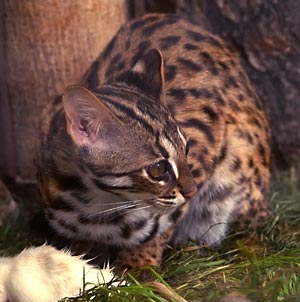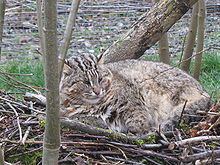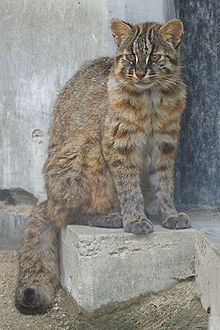Bengal cat
| Bengal cat | ||||||||||||
|---|---|---|---|---|---|---|---|---|---|---|---|---|

Bengal cat (subspecies P. b. Bengalensis ) |
||||||||||||
| Systematics | ||||||||||||
|
||||||||||||
| Scientific name | ||||||||||||
| Prionailurus bengalensis | ||||||||||||
| ( Kerr , 1792) |
The Bengal cat ( Prionailurus bengalensis ) or leopard cat , known in English as the Asian Leopard Cat (ALC) , is a wild cat from South and East Asia . Since 2002 the Bengal cat has been listed in the Red List of Endangered Species of the International Union for Conservation of Nature ( IUCN) as least concern because it is widespread. However, in part of its range it is threatened by habitat loss and hunting.
features
The Bengal cat is about the size of a house cat , but slimmer and has longer legs. Her head is marked with two distinctive dark stripes, relatively small with a light, short and narrow snout and round ears, which are black on the back with a small light spot in the middle. It has black spots of various sizes and shapes on the body and limbs and two to four rows of elongated spots across the back. The tail is spotted with a few rings at the end. The background of their spotted fur is yellow-brown to silver-gray in color with a white belly. The color and size of the spots as well as body size and weight vary so much in their wide area of distribution that they have been mistaken for different species. Bengal cats living in the tropics weigh between 550 g and 3.8 kg with a head-trunk length of 38.8-66 cm and a tail length of 17.2-31 cm. Those living in northern China and Siberia weigh up to 7.1 kg with a head-trunk length of up to 75 cm; they usually gain weight before winter, which they lose again by spring.
The Bengal cat is characterized by great intra-species variability. Above all, Bengal cats from the northern parts of the distribution area, e.g. from Eastern Siberia, differ considerably from the forms from areas near the equator. In the south the basic color is yellowish-brown, similar to a leopard , in the north it is pale silver-gray. The spots are large rosettes in northern populations and small spots in southern Bengal cats.
distribution and habitat

blue - P. b. bengalensis ,
yellow - P. b. euptilura ,
red and green - the range of the sunda cat
Bengal cats are the most common small cats in Asia . Their distribution ranges from the Amur region in the Far East of Russia via Korea , China , Indochina , west to north Pakistan and south to the Malay Peninsula . They can be found in agricultural regions, but prefer forested areas. They live in evergreen tropical rainforests and plantations at sea level as well as in subtropical humid mixed forests and coniferous forests in the foothills of the Himalayas at altitudes over 1000 m. In 2009, a Bengal cat in Nepal's Makalu-Barun National Park was photographed at an altitude of 3,254 m using a camera trap . At least six individuals live in the area of the study, which is dominated by rhododendron , oak and maple . In the northeast of their range, they live near rivers, valleys and canyon forests , but avoid areas with more than 10 cm of snow. They are rare in arid treeless areas of Pakistan.
In Thailand's Phu Khieu game reserve, 20 Bengal cats were provided with radio collars between 1999 and 2003 . The male cats were 2.2 km 2 to 28.9 km 2 in size, those of the 6 cats were between 4.4 km 2 and 37.1 km 2 in size.
Subspecies and their distribution
Of the numerous subspecies of the Bengal cat described in the past, the IUCN Cat Specialist Group only recognizes two today:
- P. b. bengalensis (Kerr, 1792) - occurs in India , Myanmar , Thailand , the Malay Peninsula , Indochina, and in southern and central China.
- P. b. euptilurus ( Elliott 1871) - the Amur cat lives in Manchuria , Korea, Taiwan , on the island of Tsushima and in the Russian Amur region near Vladivostok .
The Iriomote cat found on the Japanese island of Iriomote , which at times had the status of an independent species, is now only considered a population of P. b. euptilurus and no longer has the status of a subspecies of the Bengal cat.
The Amur cat ( Prionailurus bengalensis euptilurus ) from Northeast Asia could represent a species of its own, but genetic studies have so far not provided any clear results. The genetic differences between Amur cats and Bengal cats from Southeast Asia are so great that classification as a separate species seems justified; however, the differences to Chinese Bengal cats are so small that a taxonomic classification as a subspecies is appropriate.
The small cats of the Malay archipelago , originally attributed to the Bengal cat, now form a separate species, the Sunda cat ( Prionailurus javanensis ). Genetically, it differs significantly from the Bengal cat and is also significantly smaller. The two species are said to have separated about 2 million years ago.
The Bengal cat was domesticated in China more than 5000 years ago. Investigations of the fossil mandibles of Chinese domestic cats from 4900 to 5500 years ago showed that they were Bengal cats at that time. The domesticated Bengal cats were later displaced by introduced house cats . All domestic cats in China today belong to the species Felis catus .
Way of life
Bengal cats are loners. They can climb well, rest in trees, but also hide in thickets on the ground. Some are active during the day; however, they hunt mostly at dusk and at night, mainly long-tailed mice , shrews and hares .
They can swim well and have colonized small islands some distance from the coast. Their prey includes birds, reptiles, fish and crustaceans.
threat
The Bengal cat is hunted for its fur, especially in China. Between 1984 and 1989 about 200,000 skins were exported annually. An investigation conducted at Chinese fur traders in 1989 found over 800,000 pelts in inventory. Since the European Union banned the import of manual skins , Japan has become the main customer, importing 50,000 skins in 1989. Although the trade has subsided, Bengal cats are still hunted for their fur, for food, or captured for use as pets.
Between 1991 and 2006, surveys in four markets in Myanmar recorded 483 body parts from at least 443 individuals. Three of the markets examined are located near international borders between China and Thailand and target international buyers. While the Bengal cat is extensively protected by Myanmar's national legislation, enforcement of these laws and the enforcement of the Washington Convention on Endangered Species are considered inadequate.
natural reserve
Prionailurus bengalensis is listed in Appendix II of the Washington Convention on the Protection of Species and is under nature protection in most of the countries in its range. The populations in Bangladesh, India and Thailand are accorded the highest protection in national law. Bengal cat hunting is prohibited in Afghanistan, Bangladesh, Cambodia, Hong Kong, India, Japan, Malaysia, Myanmar, Nepal, Pakistan, Russia, Thailand and Taiwan.
In the Endangered Species Act of the United States is Prionailurus bengalensis as vulnerable ( endangered ) listed.
Since 1995 the Japanese government has supported a conservation program for the Tsushima leopard cat ( Japanese 対 馬 山猫 , Tsushima yamaneko , “Tsushima mountain cat”), which is listed as critically endangered on the Japanese Red List.
Taxonomic history
In 1792, in his translation of Carl von Linné's Systema Naturae , Robert Kerr first described the Bengal cat as Felis bengalensis, native to southern Bengal . 20 descriptions were published between 1829 and 1922, the authors of which classified Bengal cats under the genus Felis and Leopardus . Because of the individual color variations, Bengal cats from the sphere of influence of British India were described as Felis nipalensis and Felis pardochrous from Nepal, Leopardus ellioti from the Bombay area , as Felis wagati and Felis tenasserimensis from Tenasserim and Leopardus horsfieldi from Bhutan. Only Reginald Innes Pocock assigned them to the genus Prionailurus in 1939 . He had a few skulls and several dozen furs that came from many regions. On the basis of this broad spectrum of fur, he proposed to differentiate between a southern subspecies Prionailurus bengalensis bengalensis from warmer latitudes and a northern subspecies from the Himalayas, Prionailurus bengalensis horsfieldi , since the latter grows a thicker coat in winter than the southern ones. Using seven skins from the area around Gilgit and Karachi , he described Bengal cats under the name Treveleyan's Bengal cat Prionailurus bengalensis trevelyani , because these skins were longer-haired, paler and grayer than those from the Himalayas. He speculated that trevelyani live in more rocky, less forested habitats than bengalensis and horsfieldi .
Furs and skulls originating from China were described between 1837 and 1930 as Felis chinensis , Leopardus reevesii , Felis scripta , Felis microtis , decolorata , ricketti , ingrami , anastasiae and sinensis , which were later summarized under Felis bengalensis chinensis . After British naturalists spotted wildcats on the island of Tsushima in the Korea Strait and sent furs to London during an exploration trip to East Asia at the beginning of the 20th century , Oldfield Thomas classified the population under Felis microtis , which Henri Milne-Edwards described in 1872.
The similarity of two skins from Siberia motivated Daniel Giraud Elliot to describe Felis euptilura in 1871 . One skin was shown on a drawing with a description by Gustav Radde ; the other was part of a collection in the Zoological Gardens at Regent's Park . Both were light brownish-yellow, markedly gray with red-brown spots, a gray head and dark red stripes over the cheeks. As Felis manchurica , Tamezo Mori described a similarly spotted cat in 1922, but drawn in a lighter gray, based on a fur from near Mukden in Manchuria. Later both were grouped under the trinomen Felis bengalensis euptilura as a subspecies of the Bengal cat. In the 1970s, Russian zoologists such as Geptner, Gromov and Baranova contradicted this classification, which had prevailed until then. They attached importance to the term Amur cat , as the skins and skulls available to them were very different from those that came from Southeast Asia, and they considered the Amur cat as a separate species. In 1987, Chinese zoologists pointed out that those in the northeast Cats found in China have great similarities with both the Amur cats found further north and the Bengal cats found further south. In view of this, they argued that classifying the Amur cat as a species was not justified.
Crossbreed with domestic cats
Bengal and house cats can be crossed. The Bengal cat breed , which is called "Original" in German (in English the original is called Leopard Cat ), was bred from such hybrids. The Bengal is now a breed not only recognized by the TICA .
Web links
Individual evidence
- ↑ a b c J. Sanderson, S. Sunarto, A. Wilting, C. Driscoll, R. Lorica, J. Ross, A. Hearn, S. Mujkherjee, JA Khan, B. Habib, L. Grassman: Prionailurus bengalensis . 2008. In: IUCN 2010. IUCN Red List of Threatened Species. Version 2010.4.
- ^ A b M. E. Sunquist, F. Sunquist: Leopard Cat Prionailurus bengalensis (Kerr, 1792). In: Wild cats of the world. University of Chicago Press, 2002.
- ^ A b Don E. Wilson, Russell A. Mittermeier (eds.): Handbook of the Mammals of the World. Volume 1: Carnivores. Lynx Edicions, 2009, ISBN 978-84-96553-49-1 , pp. 162 f.
- ↑ a b c d AC Kitchener, C. Breitenmoser-Würsten, E. Eizirik, A. Gentry, L. Werdelin, A. Wilting, N. Yamaguchi, AV Abramov, P. Christiansen, C. Driscoll, JW Duckworth, W. Johnson, S.-J. Luo, E. Meijaard, P. O'Donoghue, J. Sanderson, K. Seymour, M. Bruford, C. Groves, M. Hoffmann, K. Nowell, Z. Timmons, S. Tobe: A revised taxonomy of the Felidae . The final report of the Cat Classification Task Force of the IUCN / SSC Cat Specialist Group. In: Cat News. Special Issue 11, 2017, pp. 26–28.
- ↑ Y. Ghimirey, B. Ghimire: Leopard Cat at high altitude in Makalu-Barun National Park, Nepal. In: Catnews. 52, 2010, pp. 16-17.
- ^ VG Geptner, AA Sludskii: Mlekopitaiuščie Sovetskogo Soiuza. Vysšaia Škola, Moskva 1972. (Original in Russian; English translation: VG Heptner, AA Nasimovich, AG Bannikov, AA Sludskii, RS Hoffmann: Mammals of the Soviet Union. Vol III: Carnivores (Feloidea). Smithsonian Institute and the National Science Foundation , Washington DC 1992.)
- ^ TJ Roberts: The mammals of Pakistan . Ernest Benn, London 1977.
- ^ A b L. I. Grassman Jr, ME Tewes, NJ Silvy, K. Kreetiyutanont: Spatial organization and diet of the leopard cat (Prionailurus bengalensis) in north-central Thailand. In: Journal of Zoology. (London) 266, 2005, pp. 45-54.
- ^ Y. Imaizumi: A new genus and species of cat from Iriomote, Ryukyu Islands. In: Journal of Mammalian Society Japan. 3 (4), 1967, p. 74.
- ^ R. Masuda, MC Yoshida: Two Japanese wildcats, the Tsushima cat and the Iriomote cat, show the same mitochondrial DNA lineage as the leopard cat Felis bengalensis. In: Zoological Science. 12, 1995, pp. 655-659.
- ^ SJ O'Brien et al .: Sympatric Asian felid phylogeography reveals a major Indochinese-Sundaic divergence . In: Molecular Ecology. 23, 2014, pp. 2072-2092. doi: 10.1111 / mec.12716
- ↑ RP Patel, S. Wutke, D. Lenz, S. Mukherjee, U. Ramakrishnan, G. Veron, J. Fickel, A. Wilting, DW Förster: Genetic structure and phylogeography of the Leopard cat (Prionailurus bengalensis) inferred from mitochondrial genomes. In: Journal of Heredity. Volume 108, No. 4, 2017, pp. 349-360. doi: 10.1093 / jhered / esx017
- ↑ Jean-Denis Vigne, Allowen Evin, Thomas Cucchi, Lingling Dai, Chong Yu, Songmei Hu, Nicolas Soulages, Weilin Wang, Zhouyong Sun, Jiangtao Gao, Keith Dobney, Jing Yuan: Earliest “Domestic” Cats in China Identified as Leopard Cat (Prionailurus bengalensis). In: PLOS ONE. January 2016. doi: 10.1371 / journal.pone.0147295
- ↑ K. Nowell, P. Jackson: Wild Cats: Status Survey and Conservation Action Plan. Leopard Cat Prionailurus bengalensis (Kerr 1792): Principal Threats. ( Memento of July 24, 2011 in the Internet Archive ) IUCN / SSC Cat Specialist Group, Gland, Switzerland 1996.
- ^ CR Shepherd, V. Nijman: The wild cat trade in Myanmar. (PDF; 1.1 MB). TRAFFIC Southeast Asia, Petaling Jaya, Selangor, Malaysia 2008.
- ^ WC Wozencraft: Prionailurus bengalensis. ( Memento of December 3, 2011 in the Internet Archive ) In: Don E. Wilson, DM Reeder: Mammal Species of the World: A Taxonomic and Geographic Reference . Third edition. Johns Hopkins University Press, 2005, ISBN 0-8018-5789-9 .
- ^ A. Murayama: The Tsushima Leopard Cat (Prionailurus bengalensis euptilura): Population Viability Analysis and Conservation Strategy . MSc thesis in Conservation Science. Imperial College, London 2008.
- ^ R. Kerr, SG Gmelin: The animal kingdom or zoological system of the celebrated Sir Charles Linnaeus: class I. Mammalia: containing a complete systematic description ... being a translation of that part of the Systema Naturae. Murray, London 1792.
- ^ A b c JR Ellerman, TCS Morrison-Scott: Checklist of Palaearctic and Indian mammals 1758 to 1946 . 2nd Edition. British Museum of Natural History, London 1966, pp. 312-313.
- ^ RI Pocock: The Fauna of British India, including Ceylon and Burma. Mammalia. - Volume 1. Taylor and Francis, London 1939, pp. 266-276.
- ^ O. Thomas: The Duke of Bedford's zoological exploration in Eastern Asia. - VII List of mammals from the Tsu-shima Islands . In: Proceedings of the Zoological Society of London. January-April 1908, pp. 47-54.
- ^ DG Elliott: Remarks on Various Species of Felidae, with a Description of a Species from North-Western Siberia . In: Proceedings of the Scientific Meetings of the Zoological Society of London. 1871, pp. 765-761.
- ^ T. Mori: On some new Mammals from Korea and Manchuria. Felis manchurica, sp. n. In: Annals and magazine of natural history: including zoology, botany and geology. Vol. X, Ninth Series, 1922, pp. 609-610.
- ↑ VG Heptner: On the systematic position of the Amur forest cat and some other east Asian cats Placed in bengalensis Felis Kerr, 1792. In: Zoologicheskii Zhurnal. Volume 50, 1971, pp. 1720–1727 (Russian)
- ↑ IM Gromov, GI Baranova, GF Baryšnikov (ed.): Catalog mlekopitaûŝih SSSR: pliocen - sovremennostʹ. Zoologičeskij Institute "Nauka." Leningradskoe otdelenie, Leningrad 1981.
- ↑ Yaoting Gao include: Fauna Sinica. Mammalia. Vol. 8: Carnivora. Science Press, Beijing 1987. (Chinese)

